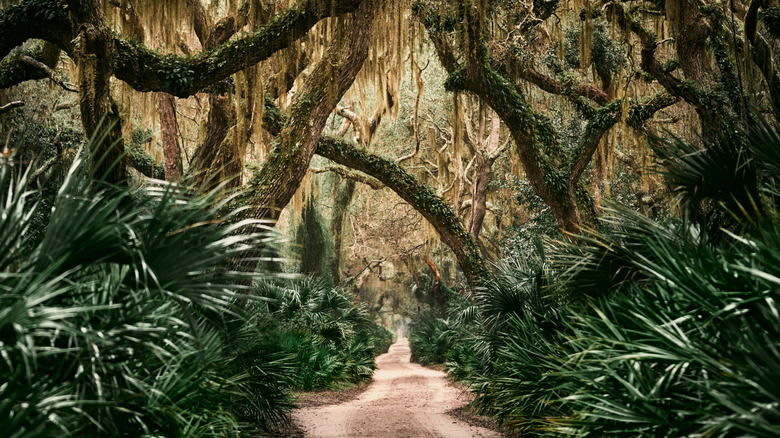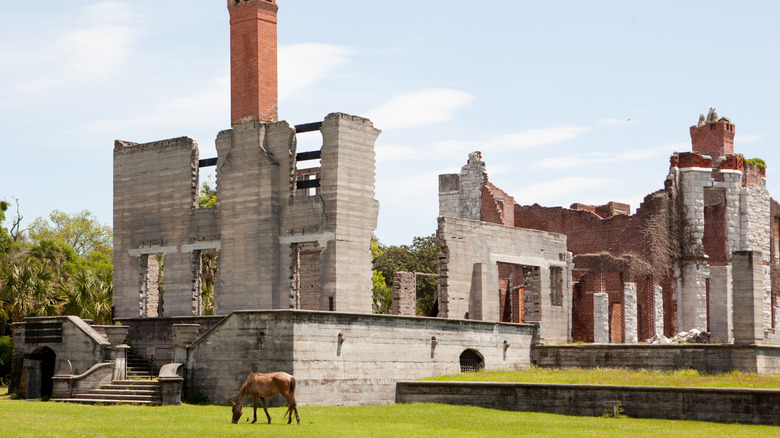Hidden South Of Savannah Is Georgia's Largest Barrier Island Full Of Wild Horses And Beachy Campgrounds
Most travelers to Georgia seeking moss-draped streets and historic charm head to Savannah, the state's oldest city. However, for those drawn to a wilder, more enchanting landscape, a scenic drive south of Savannah and a ferry ride lead to the pristine beauty of Cumberland Island. In this maritime forest, towering live oaks stretch their thick branches overhead, forming a canopy above a packed-soil trail. Follow it far enough, and it opens to a breathtaking sight: wild horses roam wide, untouched beaches of white sand, and the remains of historic ruins.
Cumberland Island, Georgia's largest barrier island, spans more than 36,000 acres of diverse ecosystems. Its history dates back over 4,000 years, when Timucuan Indians first inhabited the island before Spanish explorers arrived in the 1500s. Over the next two centuries, England, France, and Spain fought to occupy the island. Both Spain and France established missionaries during periods of territorial disputes, including raids by pirates. The conflict eventually ended with the Treaty of Paris in 1763, when Florida, along with Cumberland Island, was ceded to England.
Soon afterward, American settlers claimed land and established plantations to cultivate cash crops, such as cotton and citrus fruit. Following the Civil War, the island became a retreat for the wealthy. In 1972, Congress designated Cumberland Island as a National Seashore. Today, approximately 60,000 visitors visit every year to view its natural beauty, wilderness, and remnants of its past.
Planning a trip to Cumberland Island
Reaching Cumberland Island requires some planning, but the journey is well worth it. The only access is by ferry ride from the Mainland Visitor Center in St. Marys, the coastal town often called the Gateway to Cumberland Island. In case tickets sell out, it's wise to book a ride in advance from the Cumberland Island Ferry website. Based on age, ferry tickets range from $15 to $20, with children under 5 years and younger getting in free, at the time of this writing. Ferries operate year-round with daily service from spring through fall, and five days a week in winter, with no service on Tuesdays and Wednesdays. Travellers are advised to arrive an hour before their scheduled departure time.
The closest airport to the ferry is Jacksonville International, located about 32 miles from St. Marys. If you're flying into Savannah/Hilton Head International instead, expect a drive of roughly one hour and 50 minutes to the Mainland Visitor Center. While it's best to reserve ferry tickets online, same-day round-trip tickets are available on a first-come, first-served basis. Upon arrival, check in and pay a park entrance fee, unless you have an America the Beautiful National Park pass, which covers the cost. The entrance fee is $15 as of 2025.
The 45-minute ferry ride to Cumberland Island is picturesque, offering sweeping views of salt marshes and deep blue waters. The ferry stops at two docks: Sea Camp and Dungeness. Travelers planning to camp or swim at the beach should disembark at Sea Camp. Those who get off at the Dungeness Dock can enjoy a half-mile walk beneath oak canopies, along a forested trail scattered with ferns, fallen leaves, and fungi. The path leads to the Dungeness Ruins, one of the island's most iconic attractions.
Camping and historic ruins on Cumberland Island
If you plan to stay overnight on Cumberland Island, your options are between camping and staying in the only hotel on the island, Greyfield Inn. Cumberland Island has five campgrounds. Two of them, Sea Camp and Stafford Beach, offer basic amenities, such as toilets, showers, and drinking water. The additional three campgrounds are on wilderness sites with no facilities. All campsites require a permit, which can be obtained through recreation.gov. Whether you stay overnight or visit for a day, Cumberland Island offers several must-see attractions.
The Dungeness Ruins, once a sprawling 59-room mansion, served as the home of Thomas Carnegie, the brother of steel tycoon Andrew Carnegie, and his family during the 1880s. The grand estate stood for 75 years before being destroyed by fire in 1959. Today, visitors can wander the grounds where, even among the decay, the site remains captivating, surrounded by wild horses, armadillos, and deer that roam freely through the area.
If you're interested in a glimpse of a Carnegie home that is still intact on Cumberland Island, head to Plum Orchard Mansion for a free guided tour. Built in 1898, the mansion was commissioned by Thomas Carnegie's wife as a gift to their son and daughter-in-law to celebrate their marriage. After exploring the island's historical homes, find time to walk the 17.5 miles of undeveloped coastline. The beaches stretch wide and are bordered by sand dunes, plants, and sea oats. Whether you're collecting shells or soaking in the ocean breeze, this natural shoreline offers a peaceful escape far from the city sounds.


